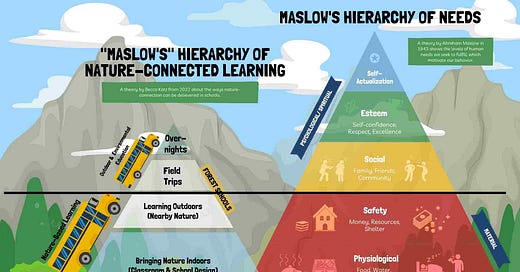Hi again. I know I just wrote last week, but I’m on a tear.
I’m writing letters because my goal is to make this as analog-in-digital as possible. Because I’m a bit of a luddite who bristles at the virtual world. Still, I’m also a pragmatist trying to mainstream nature-based learning in PK-12 education.
Tl;dr
For the uninitiated (ahem…yours truly until about 4 minutes ago), Tl;dr means “Too long; didn’t read.” I’ve decided to start using this slick convention built for the cut-throat attention economy — and, as long as I’ve already jumped off the cliff, I’ll use ChatGPT to help me generate it.
I’m proposing another metaphor for nature-based learning: a mountain. In this metaphor, immersive Outdoor Education and Environmental Education experiences are in the alpine zone, while nature-based learning is below treeline on the mountain's flanks. This metaphor positions nature-based learning in line with food, clean air and water, and shelter, in Maslow's Hierarchy of Needs.
This metaphor highlights the cultural and contextual relevance of nature-based learning, as it can be implemented in public schools and nearby-nature spaces, allowing for more equitable access to nature's benefits.
The real letter: Mountain
The iceberg I wrote to you about before is a helpful, but basic, way to talk about nature-based learning.
A far more beautiful and complete metaphor is that of a mountain (Kudos to Andrew Wolff for seeing that as soon as I showed him Maslow’s Hierarchy of Nature-Connected Learning aka “The Pyramid” which I’ve written about before). In the mountain metaphor, immersive Outdoor Education (OE) and Environmental Education (EE) experiences are in the alpine zone while nature-based learning is below treeline on the mountain’s flanks. I like this. It reminds me of a quote:
It’s the sides of the mountain which sustain life, not the top. -Robert Pirsig
That checks out. Nature connections support: Ability to self-regulate. Reduced stress. Enhanced resilience in the face of ACES (adverse childhood experiences). Lowered likelihood of chronic diseases like asthma, heart disease, and diabetes.
Set side-by-side with Maslow’s actual work, Maslow’s Mountain of Nature-Connected Learning positions nature-based learning in line with food, clean air and water, shelter.
Another thing I like about the use of a mountain is that people don’t live at the top of the mountain. Few get to visit the peak. We live on the mountain’s shoulders and in the valleys – and vast plains – that gently rise up to become the shoulders which join together somewhere in a high point. I think to really illustrate this metaphor, the bottom of the mountain needs to spread out to incorporate the flat lands where most people actually live. Like this.
A Mountain also captures cultural and contextual relevance. Relatability. Access. Meaning. This is a piece I hadn’t initially identified. Some powerful conversations (especially with Erin Allaman) and lots of reading about equity in the outdoors (LOVE LOVE I Said I Wasn’t Outdoorsy But I Lied by Nadia Mercado) highlighted that those mountain-top experiences are far from the only way to connect with nature.
Nature-based learning in school, especially in public schools – which almost 50 Million school-age kiddos in the US attend – sets the stage for all kinds of meaningful, relevant, contextualized nature connection. Students who engage in nature-based learning with their teachers at school in nearby-nature spaces can actually share backyard nature with their families, unleashing a positive feedback loop of families getting access to nature’s benefits and forging traditions steeped in their very own meaningful way of being in nature together.
We have seen this play out in our work with Good Natured Learning. Students' parents tell us their families are visiting nature more because their child brought them there. I love this. Imagine a 10-year old introducing his family to the park near school. He beams, orienting them to his mental sense-of-place map. He shares sticky learning from nature-based, sensory, neural connections. He shows them his sit-spot under a giant Oak where he has carefully arranged acorns. He picks a dandelion for his dad.
What do you think?
🙏 Leave one comment here in Substack 🦄
Hugs,
B
PS - Remind me to tell you sometime about Tanya Denckla-Cobb & Tim Beatley’s Nature Diet Pyramid.






Ooh, didn’t know about Tl;dr !! Love the Maslow analogy. I will definitely tell teachers I know about this!! ❤️❤️